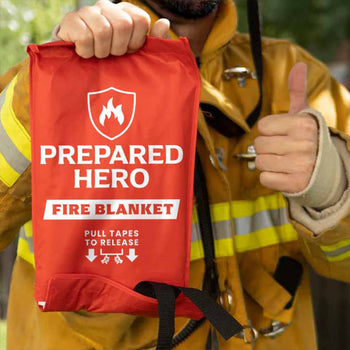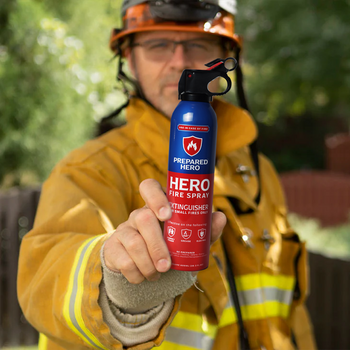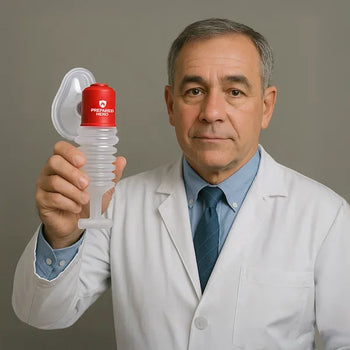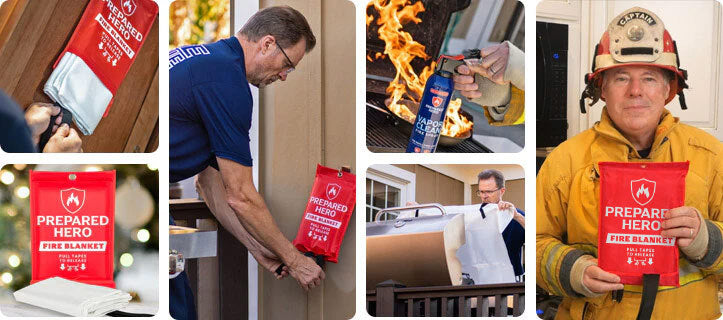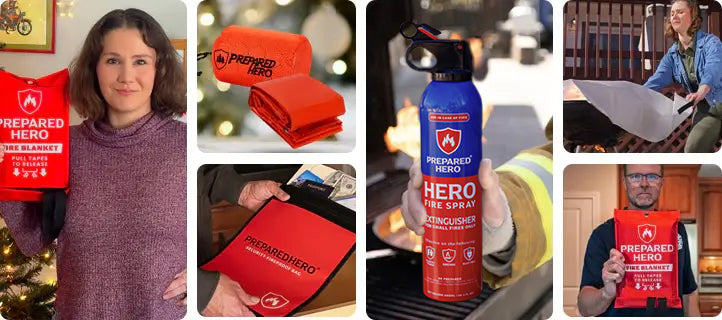Where you put your smoke detectors matters just as much as installing them. Proper placement makes sure they can detect...
According to the National Fire Protection Association (NFPA), a home structure fire was reported every 88 seconds in the US. On top of that, a home fire injury occurs every 53 minutes, while a home fire death occurs every three hours and fourteen minutes.
Sounds scary, right? To help protect you and your loved ones, we compiled the top 20 fire hazards at home.
Fire Hazards at Home
- Oil and Grease
- Kitchen Towels and Rags
- Storage Boxes
- Curtains
- Cooking Appliances
- Dryers
- Candles
- Fireplace
- Outlets
- Ashtrays
- Faulty Smoke Detectors
- Christmas Trees
- Space Heaters
- Lamps
- Documents
- Hairstyling Tools
- Laptops
- Sawdust
- Grill
- Flammable Liquids
Fire Hazards at Home: Kitchen
Here are the top fire hazards in your kitchen:
1. Oil and Grease

Cooking oil and grease are major causes of kitchen fires. They also cause the fastest-spreading type of fire.
Given this, a pot of cooking oil at high heat can be a recipe for danger. So, you must pay attention to it closely while cooking.
Additionally, cooking late at night poses the biggest risk because you might fall asleep. Hence, you must avoid late-night cooking and cook only when you can pay attention to what you're cooking.
2. Kitchen Towels and Rags

Towels and rags help you clean up oil and grease. However, what makes them so helpful can also make them fire hazards in the kitchen.
Grease and oil get trapped within their fibers, starting grease fires in the kitchen. Paper towels pose risks as well since they can easily combust. In fact, even just 3% of oil and grease residue can lead to a fire.
Hence, you must place your kitchen towels and rags away from sources of fire. If you're using paper towels, throw them right after using them.
3. Storage Boxes

If you have a huge pantry, don't fill them with paper boxes.
Cardboard boxes and food packaging quickly burn. As you may well know, a tiny spark can ignite them. Hence, regularly remove them from your kitchen.
Not only can they start fires, but they also can add fuel to fires.
4. Curtains

Many homeowners love putting curtains in their kitchens.
However, we recommend not putting them on yours, especially if you have a small kitchen. Plus, putting curtains near your stove or any fire source is a huge no-no.
Remember, curtains easily get caught in flames. The thinner the material is, the higher the chance the curtain will ignite and burn down the house.
5. Cooking Appliances

Grease buildup in hoods, ovens, and stoves can set fire to your kitchen. As mentioned above, grease easily catches fire. Hence, you have to clean your cooking appliances regularly.
Keeping a fire extinguisher near your cooking appliances also helps. The best fire extinguisher type for kitchens is wet chemical.
While fire extinguishers help, they can be expensive, heavy, and hard to store. The residue from the fire extinguisher is also hard to clean.
Get a fire spray if you want a more affordable, easy-to-clean, and eco-friendly option. The Hero Fire Spray is an easy-to-use alternative to fire extinguishers.
Plus, the fire spray is biodegradable and non-toxic. Unlike a fire extinguisher, you can safely use it around your family and pets.
6. Dryers

Your lint filter doesn't catch all the lint your dryer churns out. As a result, lint can build up inside your dryer, including its heating element. Improper clothes drying can also cause more lint to build up inside your dryer.
These cause your dryer to overheat and possibly catch fire. So, you must clean the lint filter before and after each load. Don't forget to clean the back of the dryer as well.
Fire Hazards at Home: Living Room
Here are the top fire hazards in your living room:
1. Candles

A candle flame can quickly cause a fire if it gets knocked over or placed near curtains, books, or clothing.
If you love lighting candles in your living room, never leave them unattended. You shouldn't also put them near anything that can catch fire. Lastly, keep away from children and pets.
2. Fireplace

According to the Chimney Institute of America, about 25,000 chimney fires occur in the US each year. These include gas and wood fireplaces.
However, wood fireplaces burn way hotter than gas ones. They can reach up to 2,000 degrees and set fire to other flammable materials near the fireplace.
So, have your chimney cleaned at least once a year. Additionally, you should remove any flammable materials near your fireplace.
3. Outlets

Overloaded outlets cause electrical fires. However, we use outlets every day. Hence, you must inspect your outlets at home every day.
You should also avoid overloading your outlets and unplug electrical appliances when they're not in use.
Prevent electrical fires by checking your outlets for signs of wear and tear. Then, check if your outlets are loose. Remember, loose wires can cause risky arcing.
4. Ashtrays

Never leave burning cigarettes in your ashtray. It can ignite other cigarette butts and matches. Plus, it can easily roll out of the ashtray and cause a fire.
To prevent ashtrays from starting a fire, run down the contents with water after every use.
If you regularly smoke at home, always put out your cigarette. Then, keep the ashtray away from anything flammable.
5. Faulty Smoke Detectors

Working smoke detectors save lives. Faulty ones? Not so much. In fact, they can be a fire hazard.
While faulty smoke detectors don't usually start fires, they don't warn you as working ones do.
Inspect your smoke detectors monthly. Plus, ensure they're connected so they all sound if one goes off. If your smoke detectors are more than 10 years old, replace them immediately.
6. Christmas Trees

We don't mean to ruin the holiday spirit here, but Christmas trees are one of the top common causes of fires during the holidays. According to the NFPA, Christmas trees cause 160 residential fires annually.
Plus, fires caused by real Christmas trees are more common than those caused by artificial trees. So, consider replacing your real tree soon.
But if you want to stick to a real one, keep it hydrated. Then, invest in LED lights, which don't get so hot when placed on a tree.
Fire Hazards at Home: Bedroom
Here are the top fire hazards in your bedroom:
1. Space Heaters

Portable heaters can set fire to combustible materials like curtains, paper, clothing, and flammable liquids.
According to the Consumer Product Safety Commission (CPSC), you should keep combustible materials at least three feet away from portable heaters.
The commission also recommends using safety-certified heaters only. On top of that, they shouldn't be placed on uneven surfaces where they can be knocked over.
2. Lamps

Desk lamps are among the top five leading causes of house fires worldwide. The light bulbs in these lamps mainly cause these fires.
Additionally, lamps with incandescent and compact fluorescent light bulbs become so hot they cause a fire. Halogen bulbs can also explode due to overheating, though less frequently.
Using lamps with LED bulbs is, therefore, your best option.
3. Documents

You likely have important documents stored in your bedroom. Unfortunately, paper is one of the most dangerous fire hazards. It completely burns in less than 10 seconds.
Place them inside a fireproof bag to protect your important documents and avoid fire.
4. Hairstyling Tools

Forgetting to unplug your blower, hair straighteners, or other styling tools when you're in a rush can cause a blaze quicker than you think. They can burn towels, tissue, and other combustible materials near them.
Given this, always unplug your styling tools after every use and place them on a heatproof mat.
5. Laptops

Many people leave their laptops on their beds. If you've done the same, you could've had a near-miss with a fire.
In particular, laptops can overheat, which causes the batteries to explode.
While many laptops automatically shut down when not in use, the feature might fail. Hence, you must shut down your laptop after using it and avoid putting it on flammable furniture (e.g., sofa, bed).
Fire Hazards at Home: Garage
Here are the top fire hazards in your garage:
1. Sawdust

Contrary to popular belief, sawdust can ignite and burn far quicker than whole pieces of wood. Between wiring or a spark from metals, there are several ways a sawdust pile can ignite.
So, if you have a workshop in your garage, throw the sawdust after every use.
2. Grill

Seven out of every 10 adults in the USA have a grill or smoker. But it means that most homes have an increased risk of home fires.
Grease fires and flare-ups can generate enough heat. When combined with wind, the flames can reach three or more feet from the grill.
So, place your grill away from your house, deck, and bushes. You should also regularly remove grease or fat buildup from your grill.
3. Flammable Liquids

You likely store flammable liquids in your garage, such as motor oil, paint, and gasoline.
Prevent home fires by storing flammable liquids in a cool place. Then, put them in safe containers, away from heat sources.
Frequently Asked Questions
What are fire hazards in the home?
Fire hazards in the home include oil and grease, kitchen towels and rags, storage boxes, curtains, cooking appliances, dryers, candles, outlets, ashtrays, faulty smoke detectors, Christmas trees, space heaters, lamps, documents, hairstyling tools, laptops, sawdust, grill, and flammable liquids.
What is the most common cause of fire at home?
Oil and grease are the most common cause of fire at home. They also spread the fastest.
What is the biggest fire hazard in a house?
The biggest fire hazard in a house is electrical equipment, including appliances, faulty wiring, overloaded extension cords, and loose outlets.
What are the 4 types of fire hazards?
The four types of fire hazards are:
- Solids (e.g., paper, plastic, and fabric)
- Liquids & gas (e.g., alcohol and gasoline)
- Electrical equipment (e.g., appliances and outlets)
- Metallic substances (e.g., sodium and potassium)
Conclusion

Fire hazards might be all over your home, but you have the power to prevent them from harming your family.
Follow the tips above and create a fire safety kit to protect your loved ones.
Are you looking for durable and effective items for your fire safety kit? Go to Prepared Hero and shop for fire safety items now!


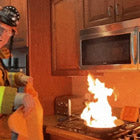 Fire
Fire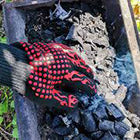 Safety
Safety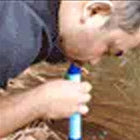 Survival
Survival Protection
Protection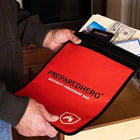 New
New
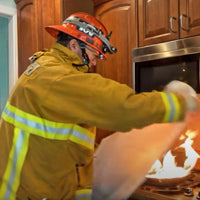 Fire
Fire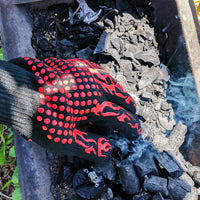 Safety
Safety Survival
Survival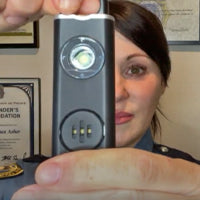 Protection
Protection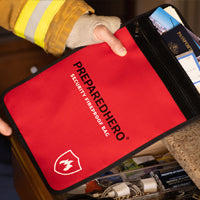 New
New
